by ROLLY B. CAIDIC
University of the Philippines Open University
Diploma in Science Teaching
Major in Biology
Ready? Get Set… Dissect!
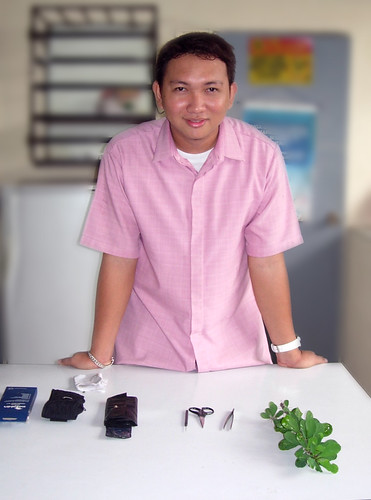
What do you know about plants and animals? I’m sure you have an idea about its parts and how it works but can you tell exactly where, why and how those parts function? In this handbook, you are going to learn biology by dissecting a euphorbia and a dog; you will need to work and think like a biologist. Most important of all, you will want to ask yourself the questions that a biologist asks:
What is this part?These are the questions that most scientist ask when they experiment. When a scientist experiment, he tries to discover a new fact or idea. Sometimes he may try to prove something people already know or think they know.
How does it function?
Why?
You will find dissection activities here that can be done by using ordinary euphorbia plant or our askal breed dogs and tools that are easily found. Just remember, a scientist watches his work carefully and thinks about what he is doing. He isn’t afraid to try something new or do it in a different way.
The experiments here are not fully described, so do them as you think they should be done.
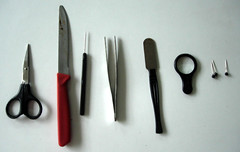
The pictures will be helpful in giving you starting ideas. Don’t be discouraged if you fail occasionally. That’s the way to experiment and discover. So are you ready? Get set… GO Dissect!
PLANT SPECIALIZATION
Crown of Thorns
Local Name in Filipino: Euphorbia
Scientific Name: Euphorbia milii var. splendens (uu-for' bee-ah mill' ee-ii splen' dens)

Kingdom Plantae – Plants
Subkingdom Tracheobionta – Vascular plants
Superdivision Spermatophyta – Seed plants
Division Magnoliophyta – Flowering plants
Class Magnoliopsida – Dicotyledons
Subclass Rosidae
Order Euphorbiales
Family Euphorbiaceae – Spurge family
Genus Euphorbia L. – spurge
Species Euphorbia milii Des Moul. – christplant
Variety Euphorbia milii Des Moul. var. splendens (Bojer) Ursch & Leandri
INTRODUCTION
The joy of planting Euphorbia
What’s this craze over euphorbia? Why are people going gaga over this thorny plant? Look around your town and you will notice that many people, whether rich or poor have euphorbia plants displayed in their front yards. Some are planted in clay pots, black plastic pots and some are planted in lowly tin cans. It’s always a pretty sight to behold - euphorbia plants teeming with pretty flowers.
It’s a staple in local gardens. Aren’t they come in different colors of yellow, pink, orange, white, red in varying shades, some are combination of colors? It’s also available in different sizes, from cute button-like blossoms to inch-sized flowers. You can also spot them being sold by ambulant vendors during market day. It seems that this craze has been going on for some time now and vendors are making good money from it.
Why Euphorbia?
As the picture shows, you can observe a lot of things from euphorbia. I think that euphorbia easily caught the fancy of plant lovers because it blooms abundantly all year round. I heard someone say that it’s not greedy with its flowers. How true! Just look at the plant when it’s in bloom. It has so many flowers, that sometimes there are more flowers than the leaves. And yes, the flowers in different sizes, variety of colors, and unique formation of petals are so captivating. You can also admire the flowers longer coz they don’t easily wilt. Another reason I suppose is that it’s very easy to propagate and grow.
Plant it yourself!
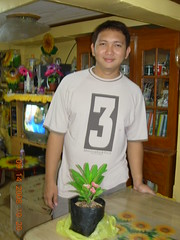
The first collection of euphorbia plants you can have is from your friends’ and neighbors’. They could give you some stems cut from the “mother” plants and plant them in pots. But wait! The newly planted cutting shouldn’t be watered for at least a week they call this technique in tagalog as “binibihag”. Why do you think they do this? Another helpful advice is that it should be exposed to sun; so it will yield an abundant bloom. This is a low maintenance plant as it has high tolerance for heat. Do we need to water it more often? What are the other planting practices should you consider in planting this kind of succulent deciduous shrub?
MAJOR EXTERNAL STRUCTURES
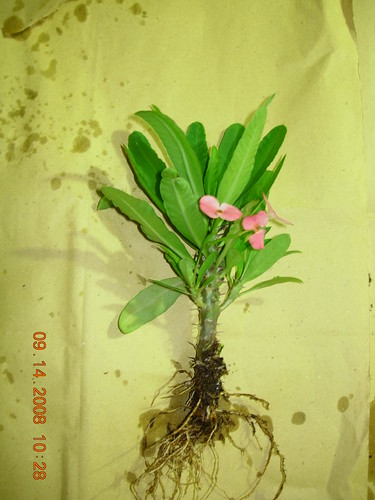
What are the major parts of a plant? What are their functions?
Watch out for the thorns! Ask an adult to help you get a plant sample of euphorbia. Use hand gloves or any protective gear when handling the plant.
Observe the picture showing the major organs of a plant. Can you see these on your euphorbia plant? What are the differences between the parts shown on the drawing and the parts of your plant sample? You can use a ruler or a tape measure in measuring your specimen. How can you describe each part of euphorbia plant?
STEM DISSECTION
What’s inside the succulent stems of euphorbia plant?
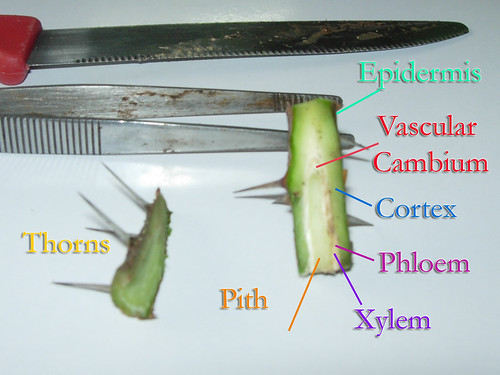
Remove all the leaves and thorns of your plant sample. Carefully cut the widest stem part crosswise. Use longer forceps and knife and hand gloves when doing this. Do you see a white – milky sap coming out of the stem? What is this sap for? Those can be very dangerous and toxic so avoid getting it on your skin and especially on your eyes! Can you see sap like this coming out from the other parts of the plant?
Wipe off the sap with a piece of cloth or paper. Then slice the stem lengthwise. How do you describe the internal parts of the stem? Can you see different layers inside the stem? What layers of the stem are saps coming from?
Identify those parts of the stem by comparing it with the diagram below.
FLOWER DISSECTION
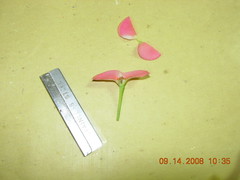
Did you know that the brightly colored ‘petals’ we see on euphorbia are actually modified leaves called ‘bracts’? The flowers which are called cyathia (singular: cyathium) are in the center, quite small and uninteresting looking. What do you think is the flower’s function? Why do you suppose the bracts of flowers of euphorbia are so colorful, uniquely shaped? Do they have some special purpose for that?
By using a scalpel or an ordinary blade cut the flower of the euphorbia plant lengthwise. Be careful not to damage the central part, remember that’s the actual flower and important parts are there. Can you identify the parts of the flower by comparing it with the picture below?
MORPHOLOGY OF EUPHORBIA

PARTS OF THE STEM
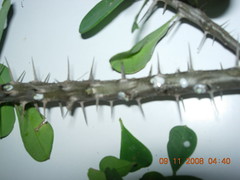
Stems are structures which support buds and leaves and serve as conduits for carrying water, minerals, and sugars. The three major internal parts of a stem are the xylem, phloem, and cambium. The xylem and phloem are the major components of a plant’s vascular system.
The vascular system transports food, water, and minerals and offers support for the plant. Xylem vessels conduct water and minerals, while phloem tubes conduct food. The vascular systems of monocots and dicots differ. While both contain xylem and phloem, they are arranged differently. In the stem of a dicot such as the euphorbia, the vascular system forms rings inside the stem. The ring of phloem is near the epidermis or external cover of the stem and is a component of the epidermis in mature stems. The xylem forms the inner ring; it is the vascular cambium in herbaceous plants.
The cambium is a meristem, which is a site of cell division and active growth. It is located between the xylem and phloem inside the bark of a stem and is the tissue responsible for a stem’s increase in girth, as it produces both the xylem and phloem tissues.
PARTS OF THE FLOWER
The sole function of the flower, which is generally the showiest part of the plant, is sexual reproduction. Its attractiveness and fragrance have not evolved to please man but to ensure the continuance of the plant species. Fragrance and color are devices to attract pollinators that play an important role in the reproductive process.
The pistil is the female part of the plant. It is generally shaped like a bowling pin and located in the center of the flower. It consists of the stigma, style, and ovary. The stigma is located at the top, and is connected to the ovary by the style. The ovary contains the eggs which reside in the ovules. After the egg is fertilized the ovule develops into a seed.
The stamen is the male reproductive organ. It consists of a pollen sac (anther) and a long supporting filament. This filament holds the anther in position so the pollen it contains may be disbursed by wind or carried to the stigma by insects, birds or bats.
Sepals are small green, leaflike structures on the base of the flower which protect the flower bud. The sepals collectively are called the calyx.
CYATHIUM
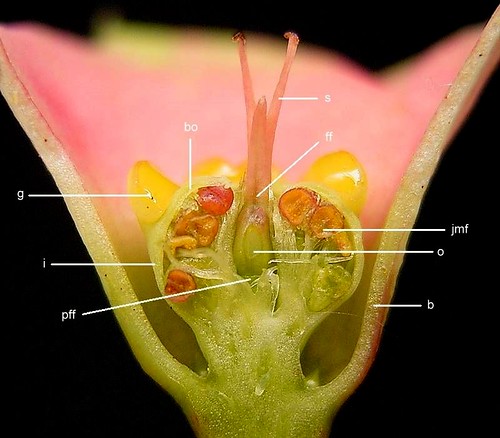
The very special pseudanthia in the genus Euphorbia (Euphorbiaceae) are known as Cyathia. A cyathium consists of:
• five (rarely four) bracteoles. These are small, united bracts, which form a cup-like involucre. Their upper tips are free and in the beginning cover the opening of the involucre (like the shutter of a camera). With these alternate:
• five (1 to 10) nectar glands, which are sometimes fused.
• one extremely reduced female flower standing in the centre at the base of the involucre, consisting of an ovary on a short stem with pistil, and surrounded by:
• five groups (one group at the base of each bracteole) of extremely reduced male flowers, which each consist of a single anther on a stem.
The flower-like characteristics of the cyathia are underlined by brightly coloured nectar glands and often by petal-like appendages to the nectar glands, or brightly coloured, petal-like bracts positioned under the cyathia.
END NOTE
Congratulations! You are now an experienced biologist. If you have kept notes on your work you will be able to check each idea that you worked on. You can even design and write about your own experiments too. Look around! Try dissecting other parts of the plant or animal you’re working on. Keep trying and you can discover a lot more.
This handbook is designed to delight and challenge the young biologists. This will help him apply methods of scientific research to find answers to these questions for himself. All the dissections can be conducted with a plant or animal and other indigenous materials.
ANIMAL SPECIALIZATION
Filipino Dog
Local Name in Filipino: “Aso”/ “Askal” (Asong kalye) / “Aspin” (Asong Pinoy)
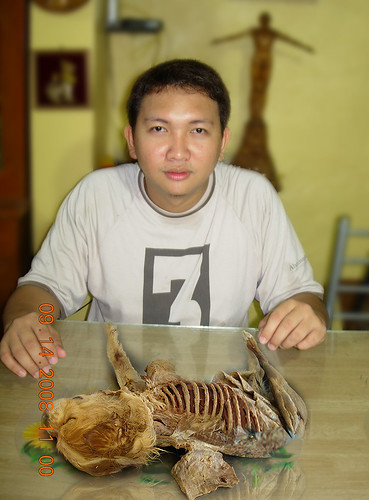
Kingdom Animalia (animals)
Eumetazoa (metazoans)
Bilateria (bilaterally symmetrical animals)
Deuterostomia (deuterostomes)
Phylum Chordata (chordates)
Craniata (craniates)
Subphylum Vertebrata (vertebrates)
Superclass Gnathostomata (jawed vertebrates)
Euteleostomi (bony vertebrates)
Class Sarcopterygii (lobe-finned fishes and
terrestrial vertebrates)
Tetrapoda (tetrapods)
Amniota (amniotes)
Synapsida (synapsids)
Class Mammalia (mammals)
Subclass Theria (Therian mammals)
Infraclass Eutheria (placental mammals)
Order Carnivora (carnivores)
Suborder Caniformia (caniform carnivores)
Family Canidae (coyotes, dogs, foxes, jackals,
and wolves)
Genus Canis (dogs, jackals, and wolves)
Species Canis lupus (gray wolf)
Subspecies Canis lupus familiaris (dog)
INTRODUCTION
The Love of Filipinos for Dogs

Do Filipinos share a special bond with Dogs? The dog is one of the most popular animals in the world. It was among the first animals to be domesticated, or trained for use by humans. It is characterized by loyalty, friendship, protectiveness, and affection. Therefore, dogs are also known as man's best friend.
The bond between dogs and people has existed for thousands of years, and dogs are still an indispensable part of the lives of farmers, ranchers, hunters, police and customs officers, and many people with disabilities, among others. In the Philippines dogs serves as “bantay” or guard of the house. They are treated just like one of the members of the family.
An askal is a mixed-breed (mongrel) dog in the Philippines. The name is a Tagalog-derived contraction of asong kalye (street dog). It is applied to mongrels due to their often stray nature. These dogs are often more resilient than pure-bred ones.
Unlike other dog breeds whose origins can be readily traced, the askal’s roots are unclear. But we do know that they have been around for a very long time. Documents dating back to the late 17th century show evidence of the existence of these dogs in Philippine soil. A photograph taken in 1904 even shows an Igorot tribesman with his hunting dog. Whether these dogs are native to the Philippines or introduced to the country by foreign traders and explorers is still debatable.
Physical Characteristics
Domestic dogs vary widely in appearance, particularly in size. The Shih Tzu, for example, is 20 to 28 cm (8 to 11 in) in length and weighs 4 to 7 kg (9 to 15 lb). The Irish wolfhound is at the other end of the scale, measuring about 71 to 94 cm (about 28 to 37 in) at the shoulder and weighing up to about 61 kg (about 135 lb). Coat color, length, texture, and pattern also vary greatly. The muzzle may appear shortened, as in the Pekingese, or elongated, as in the Doberman pinscher. Limbs are relatively short in the basset hound and dachshund, but long in the greyhound. Ear shape and carriage also vary, but these characteristics may be influenced by a dog owner’s decision to crop, or cut, the ears to make them stand up. Some dogs, notably the chow chow, even have a naturally blue-black tongue.
The askal is suitably built for the tropical climate of the Philippines. Its short and practically non-shedding coat helps the dog withstand the hot, harsh summers in our country. These dogs are, quite contrary to belief, intelligent. Their street-smart ways can attest to that. Leave another breed of dog to fend for itself on the streets and I can assure you, it cannot adapt as well as an askal can. It is also fallible to say that native dogs cannot be trained. An askal can hold its own against any breed. It is not only foreign breeds that can be taught to perform tricks. With patience and the proper training techniques, any breed of dog has the potential to learn, and an askal is no exception.
Owning Your Own Askal
Every Pinoy probably grew up with dogs around them. But the plight of askals is pitiful. Thousands live off the streets because their owners either got tired of taking care of them or because the dogs have become too much of a burden. Owning a dog entails a lot of responsibility. The decision to adopt a dog should be made carefully because it is a serious commitment that can last for several years. Small dogs may live 12 or more years, although very large dogs typically have a shorter lifespan, sometimes as brief as 8 years. Before owning a dog, potential owners should examine their lifestyle, living accommodations, and plans for the dog. Other decisions should include who, in the case of a family, will care for the dog and whether the family or individual owner will have enough time, attention, and money to meet the dog’s needs.
Askals, like any other dogs, need food, water, and most importantly, a good home. The streets are not good homes for them. They could easily get infected with canine viruses such as parvo, distemper and rabies in the streets. The high incidence of human fatalities due to rabies in our country should not be blamed on askals, but on human negligence. And sadly, hundreds of homeless askals are sent to dog pounds every year where they are put to sleep.
DISSECTION
Anatomical Direction
Before beginning a dissection, it is important to have an understanding of some of the basic directional terminology associated with the dissection of specimens. Some of these terms include proximal, which means toward the body, and distal, which means to move away from the body. Other important anatomical directions are indicated below.
Key Anatomical Directions

Dissection Safety Rules
Proper safety procedures when working with dissection tools and specimens is of greatest importance. Some safety rules to engage in when dissecting specimens are as follows.
• Follow all instructions given by your teacher.
• Inform your teacher of any illness as a result of exposure to chemicals used in specimen preparation.
• Avoid contact with preservative chemicals. Rinse the specimens completely before dissection.
• Know where the eye-wash fountain is if needed.
• Wear safety goggles to prevent the splashing of any chemicals into the eyes.
• Properly mount dissection specimens to dissecting pan. Do not dissect a specimen while holding it.
• Handle scalpel or razor blade (safety edged) with extreme care.
• Always cut away from your body and away from others.
• Never ingest specimen parts.
• Never remove specimens or specimen parts from the classroom -- until the dissection is completed all parts of the dissection must remain within the dissecting pan.
• Properly dispose of dissected materials.
• Store specimens in as directed by your teacher.
• Clean up the work area and return all equipment to the proper place when the dissection is completed.
• Wash hands after each dissection.
Dissection Equipment
The pictured dissection equipment from left to right is (1.) a teasing or dissection needle which used to pull apart muscle tissue, (2) dissecting scissors which are used to cut through tissue, and (3) a scalpel, which is a knife used to slice through and cut tissue.
ANIMAL DISSECTION
The dissection of animals is important for many reasons. It helps in the learning about the internal structures of animals. It also allows students to learn how organs and tissues are interrelated. Another purpose of dissection is to allow the comparison of organisms in terms of their organs and relative complexities. While many good simulations of dissections may be observed, it seldom can replace the benefits of the actual participation in an actual dissection.
Usually the dissection procedure involves tying the organism down firmly on the dissection pan, cutting the organism open on its ventral side (as pictured below), and pinning its tissues and muscles back to observe its internal organs. Different teachers may have their own preferences in terms of their emphasis on the tissues and organs to be observed in a dissection.
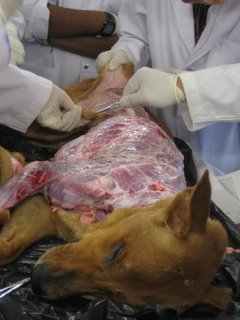
Skinning
How can you describe the skin? What is its function? Lay the cat on its back on a flat, easy to clean surface. Taking a small pair of sharp scissors, start to make a cut at the lowest point of the front of the ribcage, in the centre. Do you feel the natural hollow where your bottom ribs join the sternum? That is where you need to start cutting. Snip a shallow cut. Insert the rounded blade of the scissors just under the surface and cut up the way, in a straight line to the neck. From the neck, cut in a line towards the right corner of the mouth. Repeat the process by cutting down along the belly to reach the pubic bone (part of the pelvis). The long cut you have just made is called the ventral cut. Snip down the inside of each leg to the knee and then down to the dew claw in a smooth, clean line. At the dew claw, make a cut around the circumference of the leg, taking care not to nick any tendons.
Reaching into the ventral cut, carefully tease the skin away from the underlying muscle or bone until the skin has been freed from the body of the dog, but is still held at the head and anus. You will notice a cotton-like, fibrous material that ties the skin to the flesh. This is called the superficial fascia. Be careful to only remove the skin and not the tissue. Particular problem areas will be the flanks, the neck, the shins and particularly the head, when you get to it. Take your time and ease the skin away in the difficult areas.
Now that the skin is mostly free, it's time to start cutting again. Using the scissors, start to cut down from the pubic bone past either side of the sex organs. Cut around either side of the perineum (genitalia and anus) towards the tail, thus effectively circling this part of the dog’s anatomy. Then cut the skin between the tail and the anus, thus leaving a ring of fur around the perineum. Make a cut down the length of the tail and peel the skin away.
Muscular System
Hind Limb (medial)
Carefully remove the skin by pulling it down and off the end of the lower leg. You can cut it off if it is too difficult to remove, but do not cut any muscle fibre. The yellowish-white material under the skin is fat. Is there more fat in the thigh or the leg?
Now that the skin and fat are off, you can see the muscle – the ‘meat’. Examine the muscle and separate the bundles of muscles with your fingers. What is the function of muscles? Begin the dissection by inserting your thumb into the muscle of the lower leg. You will need to push quite hard through the shiny lining (called fascia) that is over the muscle, but it will give way at the natural separations between the muscle bundles. Continue separating the muscle into bundles by forcing your thumb and fingers through the muscle until you are able to see several separate bundles. At both ends of the muscles, you will see the strong, white cords, called tendons. What are tendons for? Can you differentiate it from muscles and other organs in the hind limb?
Thoracic Cavity
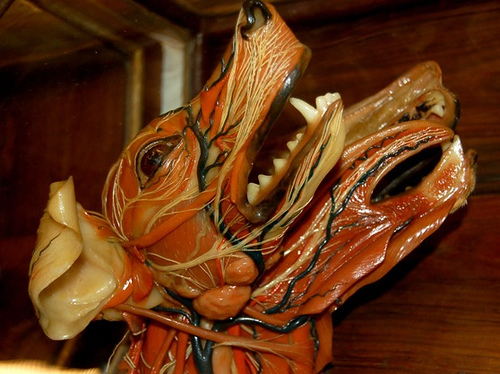
The thoracic cavity is separated from the abdominal cavity, which contains the gastrointestinal tract, by the thoracic diaphragm. The thoracic cavity contains the great vessels, the heart and the lungs, and some smaller structures.
To expose the contents of the thoracic cavity, first use a scalpel and made a transverse incision anterior to the lowest point of the front of the sternum in order to avoid cutting into the abdominal cavity. The incision was caudal to the ribs that attached to the sternum and ran from the right side of the ventral thorax to the left side of the ventral thorax. Cut across the area posterior to the clavicles and remove the cut ribcage. Can you identify the lungs and diaphragm? What organ system do they belong? The dog has right and left lungs, each covered in parietal and visceral pleura. There are how many lobes in the lungs? Can you identify them and their locations?
Carefully remove the left lung, to be able to see the dorsal aorta, esophagus, vagus nerve, and azygous vein. What organ system these organs belong to? What are its functions? The most medial of the four is the descending aorta. Lateral (left side) to it is the left vagus nerve, which is located superior to the esophagus. The esophagus is situated deep to the vagus and medial to the azygous.
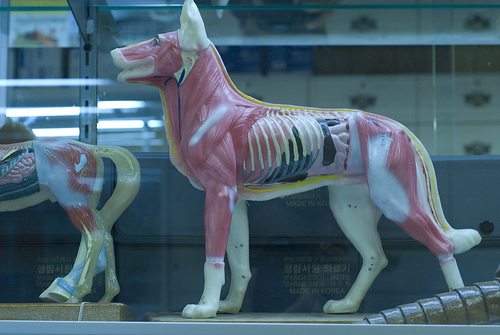
Digestive System
Hind Limb (medial)

Carefully remove the skin by pulling it down and off the end of the lower leg. You can cut it off if it is too difficult to remove, but do not cut any muscle fibre. The yellowish-white material under the skin is fat. Is there more fat in the thigh or the leg?
Now that the skin and fat are off, you can see the muscle – the ‘meat’. Examine the muscle and separate the bundles of muscles with your fingers. What is the function of muscles? Begin the dissection by inserting your thumb into the muscle of the lower leg. You will need to push quite hard through the shiny lining (called fascia) that is over the muscle, but it will give way at the natural separations between the muscle bundles. Continue separating the muscle into bundles by forcing your thumb and fingers through the muscle until you are able to see several separate bundles. At both ends of the muscles, you will see the strong, white cords, called tendons. What are tendons for? Can you differentiate it from muscles and other organs in the hind limb?
Thoracic Cavity

The thoracic cavity is separated from the abdominal cavity, which contains the gastrointestinal tract, by the thoracic diaphragm. The thoracic cavity contains the great vessels, the heart and the lungs, and some smaller structures.
To expose the contents of the thoracic cavity, first use a scalpel and made a transverse incision anterior to the lowest point of the front of the sternum in order to avoid cutting into the abdominal cavity. The incision was caudal to the ribs that attached to the sternum and ran from the right side of the ventral thorax to the left side of the ventral thorax. Cut across the area posterior to the clavicles and remove the cut ribcage. Can you identify the lungs and diaphragm? What organ system do they belong? The dog has right and left lungs, each covered in parietal and visceral pleura. There are how many lobes in the lungs? Can you identify them and their locations?
Carefully remove the left lung, to be able to see the dorsal aorta, esophagus, vagus nerve, and azygous vein. What organ system these organs belong to? What are its functions? The most medial of the four is the descending aorta. Lateral (left side) to it is the left vagus nerve, which is located superior to the esophagus. The esophagus is situated deep to the vagus and medial to the azygous.

Digestive System
 The dissection part is very simple. Make an incision on the ventral side of the dog starting at the diaphragm and continuing all the way down to the base of the tail, opening up the abdominal cavity. The organ that is most cranially situated in the abdominal cavity is the liver. What is the important function of live? What are the secretions produced by liver?
The dissection part is very simple. Make an incision on the ventral side of the dog starting at the diaphragm and continuing all the way down to the base of the tail, opening up the abdominal cavity. The organ that is most cranially situated in the abdominal cavity is the liver. What is the important function of live? What are the secretions produced by liver?The stomach is situated caudal to the rib cage in the left part of the abdominal cavity. The stomach has a few different roles in the digestion process. What are those functions? Can you identify the stomach and liver from the rest of the organs?
The structure that takes up most of the space in the abdominal cavity is the intestine. How can you describe the intestines? The intestine is usually divided into the small intestine and the large intestine. Can you identify the two types? What is its importance in digestion of food?
Excretory System
.jpg) Before the excretory system can be examined, the gut tube, and all of its associated organs (liver, spleen, gall bladder, pancreas, etc.) must be removed. Remove all of the internal organs together being careful not to damage the urogenital organs and all of their associated vasculature and ducts. The region dorsal to the guts should be cleaned.
Before the excretory system can be examined, the gut tube, and all of its associated organs (liver, spleen, gall bladder, pancreas, etc.) must be removed. Remove all of the internal organs together being careful not to damage the urogenital organs and all of their associated vasculature and ducts. The region dorsal to the guts should be cleaned.
The kidneys are “retroperitoneal” or embedded in the abdominal wall and it is surrounded by a relatively thick pad of fat. Remove the tissue and the fat surrounding the kidneys. Be careful not to damage any of the vessels running to and from the kidneys, the ureters running from the kidneys to the bladder, or the adrenal glands, which sit on the cranial end of each kidney. Can you describe the kidneys? What are its major function?
Follow the ureters caudally to the bladder. The bladder is ventral to the uterus and rectum in the pelvis. If the two ureters carry urine produced in their respective kidneys where is it stored? How does the bladder works upon urination? What part does the urine leaves the body?
Ovaries and Uterus
 Female dogs, like all female mammals, have two small ovaries. They are located caudal to the kidneys and craniolaterally to the uterus. Each has its own vascular supply and is attached to the body wall via the ovarian ligament. The ovaries are closely associated with the uterus (and indeed appear attached to it) and lie at the apex of each of the two uterine horns.
Female dogs, like all female mammals, have two small ovaries. They are located caudal to the kidneys and craniolaterally to the uterus. Each has its own vascular supply and is attached to the body wall via the ovarian ligament. The ovaries are closely associated with the uterus (and indeed appear attached to it) and lie at the apex of each of the two uterine horns.
The uterus of the dog is very different than that of the human (in fact, the cat’s uterus is closer to the typical mammalian condition) in that it has two distinct horns. In the pregnant cat, each of these horns can contain multiple developing fetuses with zonary placentas. Each fetus has its own placenta, chorion and amnion and its own pouch-like region of the uterus.
Brain
 Begin this dissection by scraping away the temporalis muscle from the anterior portion of the skull. Once the skull was visible, we used scissors to cut around the perimeter of the skull, making sure not to damage the brain. It is difficult to cut through the skull because the bone was harder and thicker than most of the other bones in the dog’s body. What is the function of the skull?
Begin this dissection by scraping away the temporalis muscle from the anterior portion of the skull. Once the skull was visible, we used scissors to cut around the perimeter of the skull, making sure not to damage the brain. It is difficult to cut through the skull because the bone was harder and thicker than most of the other bones in the dog’s body. What is the function of the skull?
Remove the top of the skull and notice the dura mater coming off attached to the inside of the skull. What do you think is this for? Using a probe, gently lifted the brain out of the head. Then cut the brain stem, fully freeing the brain from the head. Inside of the brain case, see the optic chiasm where the optic nerves cross and then enter the brain. Still attached to the brain was one of the two optic nerves. What organ is the other end of optic nerves and what is its function?
To divide the brain into its right and left hemispheres, use a scalpel cut down the longitudinal fissure of the brain. The interior view of the brain revealed the third and fourth ventricles as well as the corpus callosum. In addition, a distinct separation between the pons and medulla oblongata are visible. Can you identify these parts of the brain? What do you think are their functions?
LAST WORD
Why do we dissect animals and plants?
We dissect to provide a way for us to learn about the internal and external anatomical structures of animals and plants. By taking a hands-on learning approach, we can get a real sense of the relationships between organism’s structures. Drawings and pictures are not enough. The true feeling of being in the field and actual dissection is very different than by just imagining it.
For many students however, dissections can be very disturbing. Online dissections provide the means to experience actual dissections without all of the mess. But the real deal is not there. It is my idea not to provide all the answers in this handbook. Questions are provided to suggest things to watch for and ways to look for them to precede them with independent investigations.
REFERENCES
Bailey, Regina (2008). Virtual Cat Dissection. About.com.: Biology. Retrieved September 14, 2008, from http://clk.about.com/?zi=1/XJ&sdn=biology&cdn=education&tm=569&gps=
59_803_1276_577&f=00&su=p897.2.336.ip_&tt=2&bt=0&bts=1&zu=
http%3A//bio.bd.psu.edu/cat/
Buckley, James M. Jr. (2003). Dissection. Oswego City School District Regents Exam Prep Center. Retrieved September 10, 2008 from www.regentsprep.org/Regents/biology/units/laboratory/dissection.cfm
Dazee (2006) Euphoria over Euphorbia. Dazee Writes About. Retrieved September 12, 2008 from http://dazeee.i.ph/blogs/dazeee/2006/04/26/euphoria-over-euphorbia/
Faucon, Philippe (2005) Crown of Thorns. Desert Tropicals. Retrieved August 7, 2008, from http://www.desert-tropicals.com/Plants/Euphorbiaceae/Euphorbia_milii.html
Jacqueline (2007) Splendid Euphorbia milii in exotic and bizarre colors! John & Jacq’s Garden. Retrieved September 13, 2008, from http://www.jaycjayc.com/euphorbia-milii-crownofthorns/
Mitchell, Bob (2005) Euphorbia milii var. splendens. St. Andrew’s Botanic Garden. Retrieved August 7, 2008, from http://www.st-andrews.ac.uk/~gdk/stabotanic/nov05pom.htm
Pignatti, Sandro (1982) Flora d'Italia, Edagricole, Bologna. ISBN 8850624492. Retrieved September 14, 2008 from "http://en.wikipedia.org/wiki/Cyathium"
Tan, Michael (2007). "Askal". Philippine Daily Inquirer. Retrieved September 14, 2008, from http://opinion.inquirer.net/inquireropinion/columns/view_article.php?article_id=62750
University of Arizona (1998) Botany: Plant Parts and Functions. Arizona Master Gardener Manual. Retrieved Sept. 14, 2008 from http://ag.arizona.edu/pubs/garden/mg/botany/plantparts.html
University of Michigan (2008) Canis lupus familiaris dog. Animal Diversity Web. Retrieved Sept. 14, 2008 from animaldiversity.ummz.umich.edu/site/accounts/information/Canis_lupus_familiaris.html
Vincentz, Frank (2006) Image:Cyathium cross1 ies.jpg. Wikimedia Commons. Retrieved August 7, 2008, from http://commons.wikimedia.org/wiki/Image:Cyathium_cross1_ies.jpg
Weil, Anne (2002). Comparative Mammalian Anatomy. Duke University Biological Anthropology & Anatomy. Retrieved September 14, 2008, from www.baa.duke.edu/companat/BAA_289L_2004/index.htm
.jpg) Before the excretory system can be examined, the gut tube, and all of its associated organs (liver, spleen, gall bladder, pancreas, etc.) must be removed. Remove all of the internal organs together being careful not to damage the urogenital organs and all of their associated vasculature and ducts. The region dorsal to the guts should be cleaned.
Before the excretory system can be examined, the gut tube, and all of its associated organs (liver, spleen, gall bladder, pancreas, etc.) must be removed. Remove all of the internal organs together being careful not to damage the urogenital organs and all of their associated vasculature and ducts. The region dorsal to the guts should be cleaned.The kidneys are “retroperitoneal” or embedded in the abdominal wall and it is surrounded by a relatively thick pad of fat. Remove the tissue and the fat surrounding the kidneys. Be careful not to damage any of the vessels running to and from the kidneys, the ureters running from the kidneys to the bladder, or the adrenal glands, which sit on the cranial end of each kidney. Can you describe the kidneys? What are its major function?
Follow the ureters caudally to the bladder. The bladder is ventral to the uterus and rectum in the pelvis. If the two ureters carry urine produced in their respective kidneys where is it stored? How does the bladder works upon urination? What part does the urine leaves the body?
Ovaries and Uterus
 Female dogs, like all female mammals, have two small ovaries. They are located caudal to the kidneys and craniolaterally to the uterus. Each has its own vascular supply and is attached to the body wall via the ovarian ligament. The ovaries are closely associated with the uterus (and indeed appear attached to it) and lie at the apex of each of the two uterine horns.
Female dogs, like all female mammals, have two small ovaries. They are located caudal to the kidneys and craniolaterally to the uterus. Each has its own vascular supply and is attached to the body wall via the ovarian ligament. The ovaries are closely associated with the uterus (and indeed appear attached to it) and lie at the apex of each of the two uterine horns.The uterus of the dog is very different than that of the human (in fact, the cat’s uterus is closer to the typical mammalian condition) in that it has two distinct horns. In the pregnant cat, each of these horns can contain multiple developing fetuses with zonary placentas. Each fetus has its own placenta, chorion and amnion and its own pouch-like region of the uterus.
Brain
 Begin this dissection by scraping away the temporalis muscle from the anterior portion of the skull. Once the skull was visible, we used scissors to cut around the perimeter of the skull, making sure not to damage the brain. It is difficult to cut through the skull because the bone was harder and thicker than most of the other bones in the dog’s body. What is the function of the skull?
Begin this dissection by scraping away the temporalis muscle from the anterior portion of the skull. Once the skull was visible, we used scissors to cut around the perimeter of the skull, making sure not to damage the brain. It is difficult to cut through the skull because the bone was harder and thicker than most of the other bones in the dog’s body. What is the function of the skull?Remove the top of the skull and notice the dura mater coming off attached to the inside of the skull. What do you think is this for? Using a probe, gently lifted the brain out of the head. Then cut the brain stem, fully freeing the brain from the head. Inside of the brain case, see the optic chiasm where the optic nerves cross and then enter the brain. Still attached to the brain was one of the two optic nerves. What organ is the other end of optic nerves and what is its function?
To divide the brain into its right and left hemispheres, use a scalpel cut down the longitudinal fissure of the brain. The interior view of the brain revealed the third and fourth ventricles as well as the corpus callosum. In addition, a distinct separation between the pons and medulla oblongata are visible. Can you identify these parts of the brain? What do you think are their functions?
LAST WORD
Why do we dissect animals and plants?
We dissect to provide a way for us to learn about the internal and external anatomical structures of animals and plants. By taking a hands-on learning approach, we can get a real sense of the relationships between organism’s structures. Drawings and pictures are not enough. The true feeling of being in the field and actual dissection is very different than by just imagining it.
For many students however, dissections can be very disturbing. Online dissections provide the means to experience actual dissections without all of the mess. But the real deal is not there. It is my idea not to provide all the answers in this handbook. Questions are provided to suggest things to watch for and ways to look for them to precede them with independent investigations.
REFERENCES
Bailey, Regina (2008). Virtual Cat Dissection. About.com.: Biology. Retrieved September 14, 2008, from http://clk.about.com/?zi=1/XJ&sdn=biology&cdn=education&tm=569&gps=
59_803_1276_577&f=00&su=p897.2.336.ip_&tt=2&bt=0&bts=1&zu=
http%3A//bio.bd.psu.edu/cat/
Buckley, James M. Jr. (2003). Dissection. Oswego City School District Regents Exam Prep Center. Retrieved September 10, 2008 from www.regentsprep.org/Regents/biology/units/laboratory/dissection.cfm
Dazee (2006) Euphoria over Euphorbia. Dazee Writes About. Retrieved September 12, 2008 from http://dazeee.i.ph/blogs/dazeee/2006/04/26/euphoria-over-euphorbia/
Faucon, Philippe (2005) Crown of Thorns. Desert Tropicals. Retrieved August 7, 2008, from http://www.desert-tropicals.com/Plants/Euphorbiaceae/Euphorbia_milii.html
Jacqueline (2007) Splendid Euphorbia milii in exotic and bizarre colors! John & Jacq’s Garden. Retrieved September 13, 2008, from http://www.jaycjayc.com/euphorbia-milii-crownofthorns/
Mitchell, Bob (2005) Euphorbia milii var. splendens. St. Andrew’s Botanic Garden. Retrieved August 7, 2008, from http://www.st-andrews.ac.uk/~gdk/stabotanic/nov05pom.htm
Pignatti, Sandro (1982) Flora d'Italia, Edagricole, Bologna. ISBN 8850624492. Retrieved September 14, 2008 from "http://en.wikipedia.org/wiki/Cyathium"
Tan, Michael (2007). "Askal". Philippine Daily Inquirer. Retrieved September 14, 2008, from http://opinion.inquirer.net/inquireropinion/columns/view_article.php?article_id=62750
University of Arizona (1998) Botany: Plant Parts and Functions. Arizona Master Gardener Manual. Retrieved Sept. 14, 2008 from http://ag.arizona.edu/pubs/garden/mg/botany/plantparts.html
University of Michigan (2008) Canis lupus familiaris dog. Animal Diversity Web. Retrieved Sept. 14, 2008 from animaldiversity.ummz.umich.edu/site/accounts/information/Canis_lupus_familiaris.html
Vincentz, Frank (2006) Image:Cyathium cross1 ies.jpg. Wikimedia Commons. Retrieved August 7, 2008, from http://commons.wikimedia.org/wiki/Image:Cyathium_cross1_ies.jpg
Weil, Anne (2002). Comparative Mammalian Anatomy. Duke University Biological Anthropology & Anatomy. Retrieved September 14, 2008, from www.baa.duke.edu/companat/BAA_289L_2004/index.htm


No comments:
Post a Comment